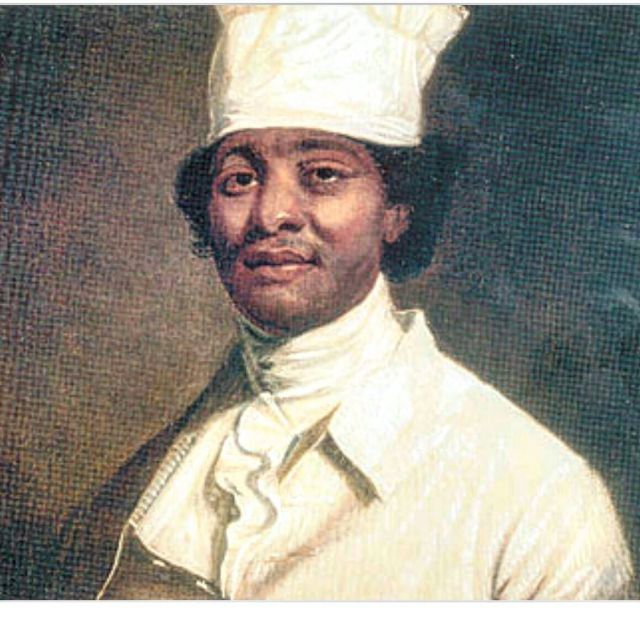Mac and Cheese in the south has a rich history of original European influence and African American adaptation. The use of pasta in conjunction with cheese to create a creamy product was present in

Europe in the 19th century. Because of Thomas Jefferson’s interest and frequent visits to France, he and his personal enslaved chef, James Hemings (pictured to the left), witnessed the dish being used in European applications. They brought these techniques back to America. Both Jefferson’s family and, more recently, James Hemings are accredited to the foundation of Southern mac and cheese. In 1802, Jefferson and Hemings’ son served, “a pie called macaroni.” – Manasseh Cutler. While Cutler was not entirely impressed by the casserole-style dish, The elite South became very interested in the dish. Via causation, “Cooking techniques were passed down from slave to slave, within the black community.” (Fowler) It was adopted as a Southern tradition among upper class citizens and a heritage dish among African American slaves that cooked for said elites. Despite the Southerner’s general distaste for the changes brought about in the Industrial Revolution, easier access to mac and cheese was favorable to most. This is when it truly adopted the name of a, “comfort food,” as it was more accessible to impoverished communities. African Americans, specifically, could use the culinary techniques of their formerly enslaved relatives to enhance mac and cheese culture. The influence of African Americans on Southern mac and cheese from this point forward is what brought the traditions surrounding it to their contemporary point.
Mac and Cheese is notably different in the South and its unique traits are what makes it southern. The signature of Mac and Cheese in the South is its baked nature. A, “roux” is made with butter and flour, and is combined with milk to make a, “bechamel.” This technique, as is hinted in the names, is native to French cuisine. Southern influence is responsible for rich cheeses that are added at the end of the bechamel process and poured into heavily boiled macaroni. Southern Mac and Cheese shows little  concern with the doneness of the pasta when compared to European techniques. Cheese and/or bread is used to top the signature casserole dish of southern mac and cheese before it is put in an oven to reduce the cheese mixture and brown the toppings. This is the most basic description of a Southern Mac and Cheese culinary process. It is often improvised and changed upon, and is very unique between different African American or other Southern families.
concern with the doneness of the pasta when compared to European techniques. Cheese and/or bread is used to top the signature casserole dish of southern mac and cheese before it is put in an oven to reduce the cheese mixture and brown the toppings. This is the most basic description of a Southern Mac and Cheese culinary process. It is often improvised and changed upon, and is very unique between different African American or other Southern families.
The distinctive traits of the process of making a Southern Mac and Cheese is symbolic of many aspects of the South. It can be observed that the process described above is very time consuming and it is a labor of love. That is entirely the nature of food in the South. The slower and familial way of life is represented perfectly by Mac and Cheese and other family style dishes like it.
Works Cited:
Fowler, Damon Lee. Dining at Monticello: In Good Taste and Abundance. Thomas Jefferson Foundation, 2005.
Person. “The History of Slavery in the Cultivation of Mac & Cheese.” ArcGIS StoryMaps, Esri, 24 Dec. 2019, storymaps.arcgis.com/stories/03dbf30ccad245b0a505f18b18fb5e8c.
“Macaroni and Cheese.” Wikipedia, Wikimedia Foundation, 27 Oct. 2020, en.wikipedia.org/wiki/Macaroni_and_cheese.

Nice, informative post.